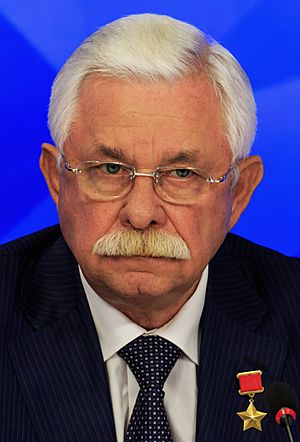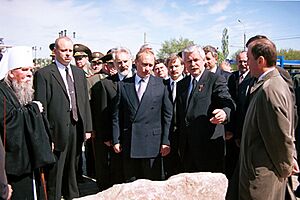Alexander Rutskoy facts for kids
Quick facts for kids
Alexander Rutskoy
|
|
|---|---|
|
Александр Руцкой
|
|

Rutskoy in 2016
|
|
| Acting President of Russia (disputed) |
|
| In office 22 September 1993 – 4 October 1993 |
|
| Preceded by | Boris Yeltsin |
| Succeeded by | Boris Yeltsin |
| Vice President of Russia | |
| In office 10 July 1991 – 4 October 1993 |
|
| President | Boris Yeltsin Himself (acting; disputed) |
| Preceded by | Office created |
| Succeeded by | Office abolished |
| Governor of Kursk Oblast | |
| In office 23 October 1996 – 18 November 2000 |
|
| President | Boris Yeltsin Vladimir Putin |
| Preceded by | Vasily Shuteyev |
| Succeeded by | Alexander Mikhailov |
| Personal details | |
| Born | 16 September 1947 Proskuriv, Ukrainian SSR, Soviet Union (now Khmelnytskyi, Ukraine) |
| Citizenship | Soviet (1947–1991) Russian (1991–present) |
| Political party | Independent |
| Other political affiliations |
Patriots of Russia (2016) Derzhava (1995–1998) DPCR/NPSR (1991–1994) CP RSFSR (1990–1991) CPSU (1970–1991) |
| Spouses | Nellie Zolotukhin (div.) Lyudmila Novikova (div.) Irina Popova |
| Children | 4 |
| Awards | Hero of the Soviet Union (1988) |
| Signature |  |
| Military service | |
| Allegiance | Soviet Union Russia |
| Branch/service | Soviet Air Force Russian Air Force |
| Years of service | 1971–1993 |
| Rank | Major general |
Alexander Vladimirovich Rutskoy (born 16 September 1947) is a Russian politician and a former military officer for the Soviet Union. He was the first and only person to ever be the Vice President of Russia, serving from 1991 to 1993.
Rutskoy is most famous for his role in the 1993 Russian constitutional crisis. During this event, the Russian parliament declared him the acting president after removing Boris Yeltsin from power. This led to a major political standoff in Moscow.
Before his political career, Rutskoy was a decorated pilot in the Soviet–Afghan War. He was awarded the title of Hero of the Soviet Union, the country's highest honor. After the 1993 crisis, he was elected governor of Kursk Oblast and served from 1996 to 2000.
Contents
Early Life and Military Career
Alexander Rutskoy was born in Proskuriv, in what was then the Ukrainian SSR, part of the Soviet Union. Today, the city is called Khmelnytskyi and is in Ukraine. He decided to become a pilot and graduated from the High Air Force School in 1971 and the Gagarin Air Force Academy in 1980.
When the Soviet–Afghan War began, Rutskoy was sent to Afghanistan as a commander of an air attack unit. He was known for his skill and bravery. During the war, his plane was shot down twice, but he safely ejected both times.
The third time his plane was hit, it was over Pakistan's airspace. He ejected again but was captured by local people and became a prisoner of war. He was held in Islamabad, the capital of Pakistan. The United States helped secure his release to avoid problems with peace agreements being made at the time.
For his service and flying 428 combat missions, Rutskoy was named a Hero of the Soviet Union in 1988. His fame as a war hero helped him enter politics.
Becoming Vice President
In 1991, Russia held its first-ever presidential election. Boris Yeltsin, a popular politician, chose Rutskoy to be his running mate for vice president. Yeltsin thought having a famous war hero on his team would help him win, and it worked. They won the election, and on 10 July 1991, Rutskoy became the Vice President of Russia.
As vice president, Rutskoy sometimes had strong opinions that differed from other leaders. He supported the independence of Transnistria from Moldova and believed that Crimea, a peninsula in the Black Sea, should belong to Russia instead of Ukraine.
In 1991, he visited Kyiv, the capital of Ukraine, to discuss gas prices. During his visit, he claimed that the Soviet Black Sea Fleet, a powerful navy group based in Crimea, should belong to Russia. This caused tension between Russia and Ukraine. The Russian parliament later passed resolutions claiming Crimea, but these were not recognized by other countries.
The 1993 Russian Constitutional Crisis
At first, Rutskoy and President Yeltsin worked together. But by the end of 1992, they began to disagree on many things. Rutskoy openly criticized Yeltsin's plans for the economy and his relationships with other countries. He also accused some government officials of being corrupt.
The disagreements grew worse. On 1 September 1993, President Yeltsin tried to suspend Rutskoy from his duties as vice president, accusing him of corruption. The Russian parliament, called the Supreme Soviet of Russia, disagreed with Yeltsin and said his action was illegal.
A Standoff in Moscow
The conflict reached its peak on 21 September 1993. President Yeltsin decided to dissolve the parliament, which was against the Russian constitution at the time. The constitution said that if a president tried to dissolve the parliament, his powers would end immediately.
In response, the parliament voted to remove Yeltsin from office. That same night, Alexander Rutskoy went before the parliament and, following the constitution, took the oath to become the Acting President of Russia.
For two weeks, Russia had two presidents. Yeltsin still controlled the government and the military, while Rutskoy had the support of the parliament. Both sides gathered their supporters at the Russian White House, the parliament building. The situation became very tense, and protests broke out in the streets of Moscow.
On 4 October 1993, Yeltsin ordered the army to storm the parliament building. The military surrounded the building and opened fire. After the building was captured, Rutskoy and his supporters were arrested. Yeltsin then officially fired Rutskoy as vice president, and the position was eliminated.
Rutskoy was held in Moscow's Lefortovo prison. In February 1994, the new Russian parliament, the State Duma, granted amnesty (a special pardon) to him and others involved in the crisis.
Governor of Kursk Oblast
After his release, Rutskoy started a new political party called Derzhava (which means "Power" or "State"). The party did not win enough votes to get into parliament in the 1995 election.
In 1996, Rutskoy decided to run for governor of Kursk Oblast, a region in western Russia. He was a popular candidate and won the election easily, with about 76% of the vote. As governor, he worked with the national government in Moscow.
In 2000, Rutskoy tried to run for a second term as governor. However, just hours before the election, a local court removed him from the race. The court said he had misused his power and had not been honest about his personal property.
Later Political Life
Rutskoy continued to be involved in politics after his time as governor. He tried to run for a seat in the State Duma in 2003 and for governor of Kursk Oblast again in 2014, but he was not allowed to be on the ballot in either election.
In 2016, he ran for the State Duma one more time with the Patriots of Russia party. His party did not get enough votes to enter parliament, and he lost the election in his district, coming in second place.
See also
 In Spanish: Aleksandr Rutskói para niños
In Spanish: Aleksandr Rutskói para niños



